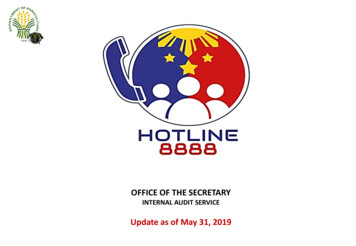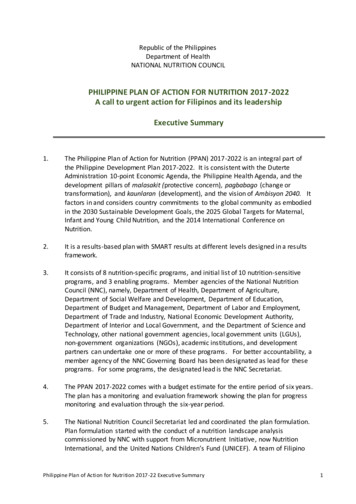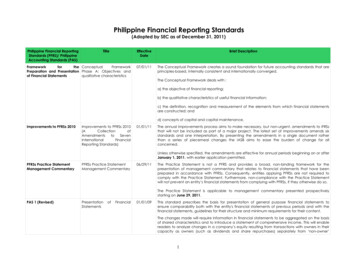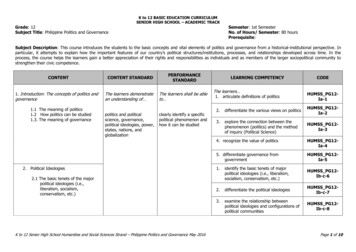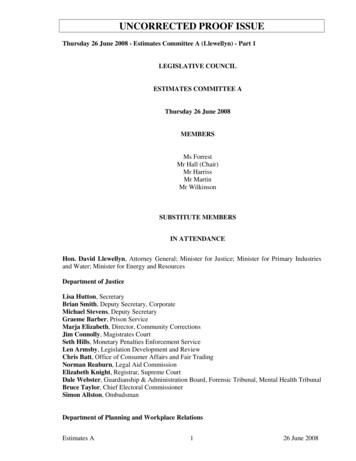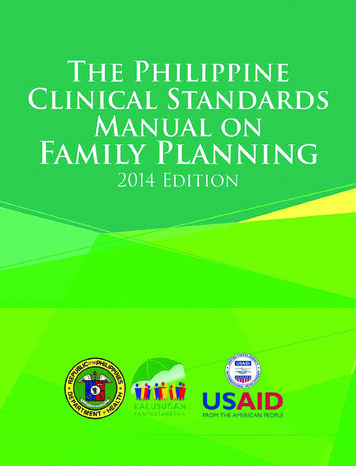
Transcription
The PhilippineClinical StandardsManual onFamily Planning2014 Edition
About the DOH and the FP ProgramThe goal of the family planning (FP) Program is to provide universal access to FP information andservices whenever and wherever these are needed. To achieve this goal, the DOH FP Program will (1)address the need to help couples and individuals achieve their desired family size within the context ofresponsible parenthood and improve their reproductive health to attain sustainable development and (2)ensure that quality FP services are available in DOH-retained hospitals, LGU-managed health facilities,NGOs, and the private sector. 2006, 2014 Department of HealthISBN: 978-971-92174-7-3ISBN:Contact address: Department of Health, San Lazaro Compound, Rizal Avenue, Sta. Cruz, Manila,PhilippinesSuggested citation:Department of Health. The Philippine Clinical Standards Manual on Family Planning (2014 Edition).Manila, Philippines: DOH. 2014. 437 pages.
TABLE OF CONTENTSForewordviiAcknowledgmentsixWhat Are the Updates?xiList of Acronyms and AbbreviationsxiiiList of TablesxvList of FiguresxviiChapter 1. Informed Choice and Voluntarism1Chapter 2. Counseling for Effective Contraception7Chapter 3. Client Assessment17Chapter 4. Combined Hormonal Contraceptives294.1 Combined Oral Contraceptives394.2 Combined Injectable Contraceptives454.3 Transdermal Patch574.4 Vaginal Ring60Chapter 5. Progestin-only Contraceptives635.1 Progestin-only Pills635.2 Progestin-only Injectables745.3 Subdermal Implants87Chapter 6. Intrauterine Devices1016.1 Copper Intrauterine Device1026.2 Intrauterine System128The Philippine Clinical Standards Manual on Family Planningiii
Chapter 7. Barrier Methods7.1 Male Condoms1357.2 Female Condoms1427.3 Diaphragm1477.4 Cervical Cap1517.5 Spermicide155Chapter 8. Fertility Awareness-based Methods1598.1 Calendar-based Method: Standard Days Method1648.2 Symptoms-based Methods168a. Two-Day Method170b. Billings Ovulation Method172c. Basal Body Temperature Method174d. Symptothermal Method176Chapter 9. Lactational Amenorrhea Method177Chapter 10. Long-acting and Permanent Methods18110.1 Bilateral Tubal Ligation18110.2 No-scalpel Vasectomy196Chapter 11. Special Populationsiv13520911.1 Contraception for the Adolescent20911.2 Contraception for Women with Obesity21311.3 Contraception for Women Smokers21711.4 Contraception for Postpartum Women21911.5 Contraception for the Perimenopause22711.6 Contraception for Women-Victims of Violence23111.7 Contraception in Disaster and Crisis Situations240The Philippine Clinical Standards Manual on Family Planning
Chapter 12. Sexually Transmitted Infections and Contraception245Chapter 13. Management of Family Planning Services259References285AppendicesA. Current Thrusts of the National Family Planning Program295B. Anatomy and Physiology of Human Reproductive Tracts313C. Pregnancy Checklist325D. PhilHealth Requirements and Benefits Related to FamilyPlanning329E. Summary Tables and Checklists: WHO Medical Eligibility Criteriafor Contraceptive Use333F. Samples of Department of Health Family Planning Forms385G. Sample Informed Consent Forms403H. Method Effectiveness405Glossary407Index413The Philippine Clinical Standards Manual on Family Planningv
FOREWORDOne of the key components for achieving Universal Health Care or KalusuganPangkalahatan is the full implementation of Republic Act No. 10354: “ResponsibleParenthood and Reproductive Health Act of 2012” (RPRH Act). This law ensuresuniversal access to reproductive health services, including family planning. TheRPRH Act and its implementing rules require the government to promote andprovide information and access, without bias, to all modern methods of familyplanning, whether natural or artificial, which have been proven medically safe,legal, non-abortifacient, and effective in accordance with scientific and evidencebased medical research standards. In this context, the DOH and its partners mustensure that family planning services are available, accessible, affordable, and ofhigh quality by making clinical practices uniform and by adapting the best medicalscience currently known.As the gold standard for family planning and contraceptive services in thePhilippines, the Philippine Clinical Standards Manual on Family Planning providesupdated content on clinical practice using existing family planning methods as wellas information on new ones. Through this manual, the DOH affirms its commitmentto ensuring quality family planning services by instituting practices that are at parwith international standards.Together with the contributors, reviewers, and editors of this manual, I hope thatthis updated version serves as an easy-to-use and reliable guide for all frontlinehealthcare professionals. Through this guide, we are ensuring the success of ourhealth programs by safeguarding the right kind and quality of service for those whoare most in need.Enrique T. Ona, MD, FPCS, FACSSecretary of HealthThe Philippine Clinical Standards Manual on Family Planningvii
viiiThe Philippine Clinical Standards Manual on Family Planning
ACKNOWLEDGEMENTSContributors and ReviewersMembers of the DOH Expert Panel in Family PlanningLourdes Capito, MDHonorata Catibog, MDMaria Cristina Crisologo, MDFrancis Floresca, MDCynthia Garcia, MDJocelyn Ilagan, MDEsmeraldo Ilem, MDCesar Maglaya, MDEnrico Gil Oblepias, MDJessica Ona-Cruz, MDRosalie Paje, MDRebecca M. Ramos, MDLylah Reyes, MDAlejandro San Pedro, MDEnriquito Lu, MDExternal ReviewerRebecca M. Ramos, MDTechnical EditorOrville Solon, PhDCarlo Irwin Panelo, MDAnnie Asanza, MDKirth Asis, MDMaria Elinor Grace Sison, MDChamuel Michael Joseph Santiago, RNDesdemona Diwata EspinaLubalin Buhawi EspinaEras Bathala EspinaTechnical SupportCopy editing, Layout, Graphic DesignThe Philippine Clinical Standards Manual on Family Planningix
DOH Panel of ReviewersEsperanza Anita Arias, MD, Quezon City Health DepartmentRosario Benabaye, MD, InterCA-LuzonHealthLuzviminda Calajate, RM, Women’s Health Care FoundationRose Camacho, RM, Integrated Midwives Association of the Philippines, Inc.Joseph Carillo, RN, DOH-RHO VIVirginia Dacpano, RM, Tumana Health CenterJoy Dinalo, RN, DOH-RHO XIJoyce Encluna, MD, Health Policy Development ProgramGliceria Enjambre, RN, Vicente Sotto Memorial Medical CenterMary Ann Evangelista, MD, Health Policy Development ProgramIsabel Ferrer, MD, Paulino J Garcia Talavera Extension HospitalJovette Guinal, MD, DOH-RHO VIILiezel Hermosilla, RN, Quezon City Health DepartmentMickhael Langit, MD, Health Policy Development ProgramVilma Maglaque, RM, Dr Jose Fabella Memorial HospitalIngrid Magnata, MD, InterCA-LuzonHealthCarmelita Manlutac, RN, Quirino Memorial Medical CenterFaith Obach, MD, Health Policy Development ProgramCherry Pangilinan, MD, InterCA-VisayasHealthKristine Romorosa, RN, Health Policy Development ProgramNanette San Diego, RM, Tumana Health CenterDionica Saquilon, RM, DOH-RHO VIICheryl Sarmiento, MD, DOH-RHO IXRhoda Tiongson, Health Policy Development ProgramPatricia Tobias, MD, West Visayas Medical CenterRobert Totanes, MD, Health Policy Development ProgramRochelle Venzon, RM, Tumana Health CenterEugene Yu, MD, Zamboanga City Medical CenterThis manual was developed with the generous support of the American people through the United StatesAgency for International Development (USAID). The contents are the responsibility of the contributors,reviewers, and editors herein listed and do not necessarily reflect the views of the UPecon Foundation,Inc., the USAID, or the United States Government.The mention (if any) of specific companies or of certain manufacturer’s products does not imply thatthey are endorsed or recommended by the DOH in preference over others of similar nature. Articles maybe reproduced in full or in part for non-profit purposes without prior permission, provided that credit isgiven to the DOH and/or the individual authors for original pieces. A copy of the reprinted or adaptedversion will be appreciated.xThe Philippine Clinical Standards Manual on Family Planning
WHAT ARE THE UPDATES?The updates featured in this version were adapted from the latest evidence-basedrecommendations and guidelines, including the (1) Medical Eligibility Criteria forContraceptive Use (4th Edition, 2010), the (2) Selected Practice Recommendationsfor Contraceptive Use: 2008 Update of the WHO, and the (3) 2013 CDC PracticeRecommendations. Specific questions on how to use different contraceptivemethods were addressed. This manual provides updates on the following: New chapter on informed choice and voluntarism (p. 1) Continuous and extended use of combined oral contraceptives (p. 41) Quick start of contraceptives (pp. 37, 42, 51, 58, 61, 68, 81, 95, 105, 122, 129, 166,168, 172, 189, 233, 238) Late reinjections for progestin-only injectables (p. 83) Correction of misconceptions about each FP method (pp. 73, 104, 116, 156,168, 172, 212) New subcutaneous DMPA (p. 74) Guidelines on the insertion and removal of contraceptive subdermal implants(pp. 91, 95) Guidelines on pelvic examination prior to IUD insertion (p. 107) Guidelines on postplacental and immediate postpartum insertion of TCu IUD(pp. 111, 115) Endoscopic and hysteroscopic bilateral tubal ligation (pp. 182, 183) When to start relying on the effectiveness of vasectomy after surgery(p. 206) Effect of increased body mass index (BMI) on certain contraceptives (p. 213) New subchapter on contraception for female victims of sexual violence, withinformation on when to initiate regular contraceptives (p. 231) Guidelines on the use of the Yuzpe method and the levonorgestrel-only pill(p. 234)The Philippine Clinical Standards Manual on Family Planningxi
Subchapter on contraception in disaster and crisis situations (p. 240)New chapter on sexually transmitted infections (p. 245)Effects of antiretrovirals on hormonal contraception (p. 255)Effects of antibiotics on contraceptives (p. 255)Relevant RPRH law provisions and related IRR (p. 306)Pregnancy checklist (p. 325)2013 PhilHealth benefits for FP (p. 329)New DOH commodity forms (p. 385)ACRONYMSxiiThe Philippine Clinical Standards Manual on Family Planning
LIST OF ACRONYMS ANDABBREVIATIONSAIDSAcquired ImmunodeficiencySyndromeCOCCombined Oral ContraceptiveAMTSLActive Management of Third Stageof LaborCPRContraceptive Prevalence RateDMPADepot-Medroxyprogesterone AcetateAOAdministrative OrderDOHDepartment of HealthARMMAutonomous Region of MuslimMindanaoDSWDDepartment of Social Welfare andDevelopmentARVAntiretroviral DrugsDVT/PEASCAmbulatory Surgical ClinicDeep Vein Thrombosis/PulmonaryEmbolismASLAuthorized Stock LevelECPEmergency Contraceptive PillBBTBasal Body TemperatureEEEthinyl EstradiolB-hCGBeta Human Chorionic GonadotropinFABMethodFertility Awareness-Based MethodBHWBarangay Health WorkerFHSISBHSBarangay Health StationField Health Services InformationSystemBMIBody Mass IndexFPFamily PlanningBPBlood PressureFSHFollicle Stimulating HormoneBTLBilateral Tubal LigationHIVHuman Immunodeficiency VirusCBMISCommunity-Based MonitoringInformation SystemHLDHigh-Level DisinfectionIEInternal ExaminationCBTCompetency-Based TrainingIECCDLMISContraceptive Distribution LogisticsManagement Information SystemInformation, Education, andCommunicationIMIntramuscularCHCCombined Hormonal ContraceptiveIUDIntrauterine DeviceCHTCommunity Health TeamIUSIntrauterine SystemCICCombined Injectable ContraceptiveLAMLactational Amenorrhea MethodThe Philippine Clinical Standards Manual on Family Planningxiii
xivLARCLong-Acting and ReversibleContraceptiveLGULocal Government UnitLHLuteinizing HormoneLNGLevonorgestrelMCPMaternity Care PackageMDGMillennium Development GoalsMECMedical Eligibility CriteriaMISManagement Information SystemNDHSNational Demographic and HealthSurveyNDSNational Demographic SurveyNET-ENNorethisterone EnanthateNFPNatural Family PlanningNGONongovernment OrganizationNOHNational Objectives for HealthNSAIDNon-Steroidal Anti-InflammatoryDrugNSVNo-Scalpel VasectomyOB-GYNEObstetrics-GynecologyPEPhysical ExaminationPhilHealthPhilippine Health InsuranceCorporationPHOProvincial Health OfficePIDPelvic Inflammatory DiseasePOCProgestin-Only ContraceptivePOIProgestin-Only InjectablePOPProgestin-Only PillRHReproductive HealthRHURural Health UnitRTIReproductive Tract InfectionsSDMStandard Days MethodSLESystemic Lupus ErythematosusSMRSupply Management RecordingSTISexually Transmitted InfectionsTCLTarget Client ListTFRTotal Fertility RateUSAIDUnited States Agency forInternational DevelopmentVSCVoluntary Surgical ContraceptionVTEVenous ThromboembolismWHOWorld Health OrganizationWRAWomen of Reproductive AgeThe Philippine Clinical Standards Manual on Family Planning
LIST OF TABLES1. Principles of ICV (p. 3)2. Client type and corresponding counseling tasks (p. 8)3. Categories used in recommending contraceptive methods based on WHO MEC (p. 18)4. Simplified MEC categories (p. 19)5. Applicability of various procedures or tests for contraceptive methods (p. 23)6. MEC categories for CHCs (p. 31)7. Low dose COCs available in the Philippines (p. 40)8. MEC categories for CICs (p. 47)9. MEC categories for POPs (p. 65)10. MEC categories for POIs (p. 76)11. MEC categories for subdermal implants (p. 89)12. Recommended timing of insertion for women shifting to implants (p. 96)13. Currently available therapies for stopping bleeding among users of subdermal contraceptiveimplant (p. 98)14. MEC categories for IUD (p. 103)15. MEC categories for IUS (p. 130)16. Pregnancy rates with consistent and correct use and abstinence on fertile days (p. 161)17. Length of time to practice abstinence and use another method before effective use of FABmethods is achieved (p. 161)18. MEC categories for FAB methods (p. 162)19. MEC categories for calendar-based methods (p. 164)20. MEC categories for symptoms-based methods (p. 169)21. MEC categories for female sterilization (p. 186)22. MEC categories for male sterilization (p. 199)23. Estimated number of pregnancies out of 100 women with unprotected sex during the second orthird week of the menstrual cycle according to the type of contraceptive used (p. 234)24. Recommended dose of acceptable brands used for the Yuzpe Method (p. 235)25. Timing of initiation and recommendations on the client’s desired FP method after the LNG andYuzpe methods (p. 238)26. Bacterial types of STIs (p. 246)27. Viral types of STIs (p. 248)The Philippine Clinical Standards Manual on Family Planningxv
28. Protozoan and lice-causing STIs (p. 249)29. Common signs and symptoms according to possible causative STI (p. 250)30. Effects of contraception on STIs with corresponding recommendations (p. 252)31. Effects of STI medications on contraceptives (p. 255)32. Recommendations on contraceptive use among clients with STI, HIV or AIDS, and on ARVs (p.256)33. Recommended minimum standards for family planning service outlets (p. 265)34. Guidelines for staff development (p. 270)35. Guidelines for setting up an information system (p. 276)36. Guidelines for preparing a work and financial plan for FPs (p. 277)37. Guidelines for mobilizing resources for FP services: Identification of resources (p. 279)38. Guidelines for the monitoring and evaluation of FP clients (p. 280)39. Basic rules for infection control (p. 282)40. Steps for FP client follow-up (p. 284)xviThe Philippine Clinical Standards Manual on Family Planning
LIST OF FIGURES1. Flow of activities and services for a new FP client (p. 26)2. Flow of activities and services for a returning FP client (p. 27)3. Procedure to follow when a woman misses her pills (p. 44)4. Two-Day Method algorithm (p. 171)5. Algorithm of the LAM (p. 178)6. Postpartum family planning methods (p. 226)The Philippine Clinical Standards Manual on Family Planning xvii
xviiiThe Philippine Clinical Standards Manual on Family Planning
Chapter 1INFORMED CONSENT ANDVOLUNTARISMWHAT IS INFORMED CHOICE AND VOLUNTARISM (ICV)?The quality of care in family planning (FP) requires that the rights of FP clients aresafeguarded by service providers at all times. The rights of FP clients, especiallythe right to information and choice, must be honored through appropriate FPcounseling. Clients must be able to make voluntary and informed choices based onaccurate, balanced, and complete information. The Department of Health (DOH) AO2011-0005 defines Informed Choice and Voluntarism (ICV) as“A standard in the delivery of FP services, ensuring that clientsfreely make their own decision based on accurate and completeinformation on a broad range of available modern FP methods,and not by any special inducements or forms of coercion ormisinterpretation.”Healthcare providers are responsible for ensuring that an FP client makes avoluntary and informed choice. This factor is considered as one of the pillars thatguide FP program implementation.The Philippine Clinical Standards Manual on Family Planning1
QUALITY OF CARE IN FP : CLIENT RIGHTS AND PROVIDER NEEDSThe quality of FP services can be further enhanced by safeguarding the rightsof clients and by providing the needs of healthcare professionals. Healthcareproviders need proper training, adequate supplies, good working environment, aswell as good management support and supervision. Basic client rights include thefollowing:Right to informationTo learn about the benefits and availability of family planningRight to accessTo obtain services regardless of sex, creed, color, marital status, socialstatus, or locationRight to choiceTo decide freely on whether to practice family planning and which methodto useRight to safetyTo be able to practice safe and effective family planningRight to privacyTo be counseled and be provided with services in a private environmentRight to confidentialityTo be assured that personal information is kept between the client andthe providerRight to dignityTo be treated with courtesy, consideration, and attentivenessRight to comfortTo be provided with utmost care and attention during serviceRight to continuityTo receive FP services and supplies as long as neededRight to opinionTo express views on the services offeredINFORMED CHOICE AND VOLUNTARY DECISION MAKING AS AVITAL PROGRAM STRATEGYThe DOH recognizes that ensuring ICV will translate to better and longer methoduse, improved client compliance, and satisfied clients who will encourage othersto participate in FP programs. This is effectively done through face-to-face, verbal,and nonverbal exchange of information with clients. ICV is a vital foundation of FPProgram success.2The Philippine Clinical Standards Manual on Family Planning
ENSURING INFORMED AND VOLUNTARY DECISIONSService providers must be aware of the principles of ICV. Table 1 explains theprinciples of ICV and provides hypothetical examples of noncompliance orvulnerability. Service providers must be aware that their best interest might violateICV principles and the rights of the client.Table 1. Principles of ICVICV PrincipleClarification/InterpretationExamples of Non-compliance/Service providers or referralagents shall not implement orbe subject to quotas or othernumerical targets relative to thetotal number of births, numberof FP acceptors, or acceptors ofa particular FP method.A quota or target is apredetermined number of births,FP acceptors, or acceptors of aparticular method that a serviceprovider or a barangay healthworker is assigned or required toachieve. Indicators for planning,budgeting, and reporting areexempted.Dionisia, the midwife–ownerof a lying-in, discovers thather employed midwife failed toachieve her required 10 PPIUDinsertions per month and thusdeducts 5% from her salary.No payment of incentives,bribes, gratuities, or financialreward to the following:Provider payments violate theprovision only when paymentis based on a quota or targetset as a predetermined numberof total births, number ofFP acceptors, or number ofacceptors of a particularmethod.The best “performing” healthproviders in a program receivesupplies and/or equipmentas reward on the basis of thenumber of FP acceptors.Program personnel forachieving a numericaltarget or quota relative tothe total number of births,number of FP acceptors, oracceptors of a particular FPmethodIncentives, bribes, gratuities,and financial rewards shouldnot be a form of inducement toaccept a particular method.No denial of rights and benefitsfor those who do not accept FP.Health facilities shall not denyany right or benefit, includingthe right to participate in anyprogram of general welfare orthe right to access healthcare,as a consequence of the decision not to accept FP services.Mothers who did not accept anyFP method are denied immunization services.Comprehensible information onchosen FP method.Clients must receive comprehensible information about therisks, benefits, side effects, andcontraindications of the methodthey want to use in accordancewith local standards.Service providers withholdfull information on FPmethods from the clients.Full disclosure for experimental contraceptive method andprocedures.The Philippine Clinical Standards Manual on Family Planning1 An individual in exchangefor becoming a FP acceptorChapter Informed Choice and VoluntarismVulnerability3
ICV PrincipleClarification/InterpretationExamples of Non-compliance/VulnerabilityInformed consent must bedocumented prior to permanentmethods, namely, bilateral tuballigation (BTL) or vasectomy.Service providers should ensurethat informed consent has beendiscussed and secured fromevery acceptor of a permanentFP method prior to the procedure. Six elements should beexplained to the clients.While Sally was in painful labor,she was asked to sign the consent for BTL.FP programs/projects mustprovide information and accessto a broad range of FP methodsand services, either directly orthrough referral.During counseling, potential FPclients should be made awareof all the modern FP methods.If methods such as intrauterinedevice and BTL, which require acertain level of skill from providers, are unavailable, the providershould be able to refer the clientto a facility where the servicesare available.Mara goes to the hospital desiring to have BTL. However, nodoctor is available to conductthe procedure. The nurse simplytells her that the method is unavailable and sends Mara homewith no alternative method orreferral.No discrimination should bemade against applicants forgrants or funding because ofreligious or conscientious commitment to offer only natural FP.Funding of programs with involuntary sterilization or coerciveabortion is not allowed.Chastity Foundation was deniedfunding because it strictly promoted only natural FP methods.Practice of abortion is illegal inthe country, as stipulated in theRevised Penal Code. Programbeneficiaries are not allowed tojoin advocacy activities lobbyingfor abortion as an FP method.INFORMED CONSENTInformed consent is different from informed choice. Informed consent is a writtenvoluntary decision of an FP client stating that he/she accepts the particular method(e.g., sterilization, IUD, or implant insertion) before undergoing the procedure. Theservice provider is assumed to have already provided adequate counseling prior tothe acknowledgment of the decision.4The Philippine Clinical Standards Manual on Family Planning
The RPRH Act of 2012 implementing rules and regulations include the followingprovisions regarding informed consent in availing FP services: Any minor availing of FP services must have written consent of their parentsor guardians. Any minor who has had a previous pregnancy or is already a parent stillrequires parental consent prior to availing of FP services. Spousal consent is needed prior to undergoing permanent surgicalChapter1Informed Choice and Voluntarismcontraceptive methods.The Philippine Clinical Standards Manual on Family Planning5
6The Philippine Clinical Standards Manual on Family Planning
Chapter 2COUNSELING FOR EFFECTIVECONTRACEPTIONGood counseling is an essential part of family planning(FP) services. It guides clients in making informeddecisions about the safest and most suitable methodof contraception that meets their needs and conditions.An effective counseling dispels clients’ fears andallows misconceptions to be corrected and clarified.Current counseling strategies emphasize clientcentered sessions, client empowerment, and an equalfooting between the provider and the client.Counseling services must be provided in person,particularly in a private and face-to-face setting. This setup helps assure the clientof the confidentiality of the counseling session.WHO IS THE FP COUNSELOR?An FP counselor is any individual who is responsible for helping a client make aninformed, voluntary, and well-considered decision about fertility and contraception.He/she may be a nurse, midwife, doctor, or health educator who has received theBasic Comprehensive FP Course or the Competency-Based Training (CBT) Level 1/Level 2. An FP counselor must have the following characteristics: Knowledgeable in the various FP methods Demonstrates a positive attitude toward work (i.e., enthusiastic, persistent,and patient) Sensitive, understanding, and helpful in addressing clients’ needs andassessing their situationsThe Philippine Clinical Standards Manual on Family Planning7
WHO IS THE CLIENT?Although each client is unique inneed, background, and situation, theprovider must consider the type ofclient in establishing the appropriatecounseling services while ensuring theindividualized nature of the counselingsession. These considerations ensurethat no important element is missedor overlooked. Table 2 describes thevarious types of FP clients and how toeffectively counsel them.Table 2. Client type and corresponding counseling tasksCLIENT TYPE: New client with a method in mindCOUNSELING TASKS1. Discuss the client’s needs and situation as well as the client’s reproductiveintent.2. Determine the correctness and accuracy of the client’s knowledge of themethod. Clarify any misconceptions.3. Determine if the client is medically eligible for the method and if themethod is suitable to the client’s needs and situation.4. If the client is eligible, discuss the correct use of the method and how todeal with side effects.5. Provide the method (including any backup as needed).6. If the client is ineligible, discuss the reasons for the ineligibility, andinform the client of other options.8The Philippine Clinical Standards Manual on Family Planning
CLIENT TYPE: New client with no method in mindCOUNSELING TASKS1. Discuss the client’s needs and situation and the factors that he/sheconsiders important in choosing an FP method.2. Discuss relevant information about each method, and assist the clientin determining the most suitable method. Include in the discussion theclient’s medical eligibility, and ensure that her choice is an informed one.3. Clarify any misconceptions.4. Discuss how to correctly use the chosen method and how to handle anyside effect.Counseling for Effective Contraception5. Provide the method.CLIENT TYPE: Returning clients with no problemsCOUNSELING TASKS1. Recheck the client’s knowledge about his/her chosen contraceptivemethod. Provide updates if any.2. Discuss how the client is doing with the current method, includingobservations that the client may deem too trivial to report but mayactually be important enough to have the method modified.3. Provide the method.CLIENT TYPE: Returning clients with problems24. Schedule a follow-up visit.1. Perform a thorough probe of the client’s concern about the currentmethod.2. Explain the possible causes, and discuss the options available to theclient.ChapterCOUNSELING TASKS3. If a new method is required, educate the client about the appropriate useand the potential side effects. Provide a temporary backup method duringthe transition if needed.4. Provide the method.5. Schedule a follow-up visit.The Philippine Clinical Standards Manual on Family Planning9
Basic contraceptive education provides essential information, especially during thefirst counseling session. The information should include the following:Method effectiveness Method effectiveness is the typical or averagelikelihood of pregnancy for all users of a particularmethod regardless of whether they have used thismethod correctly and consistently. It also refers to the lowest likelihood of pregnancywhen the method is used correctly and consistentlyas reported in reliable studies. This information includes how a method worksand the failure rates or pregnancy rates duringutilization of a particular method. Method effectiveness may be the most importantselection criterion for some clients.Advantages and disadvantages Clients have varying perceptions on the advantages and disadvantages ofeach method. The information provided to the client must therefore be adapted to his/herrequirements and current conditions. For instance, taking a pill daily may bepreferred by some while tedious for others. Some may prefer injectables orIUDs despite the temporary discomfort associated with these methods.Side effects and complications The appropriate disclosure of the side effects of a particular method helpsthe client arrive at an informed decision. It also boosts user satisfaction andmotivation for continued use. Clients must be informed that some effects are temporary or self-limitingand are not serious. However, FP service providers should emphasize thepotentially dangerous symptoms that require immediate consultation,although such cases are rare.10The Philippine Clinical Standards Manual on Family Planning
Use of the chosen method The information about the use of certain methodsshould be correct and clear because many failure casesresult from errors in usage. The provider must makesure that the client has adequately understood thedirections. A useful approach is to ask the client to repeat theinstructions to avoid misunderstandings. This part ofclient educatio
The Philippine Clinical Standards Manual on Family Planning xi WHAT ARE THE UPDATES? The updates featured in this version were adapted from the latest evidence-based recommendations and guidelines, including the (1) Medical Eligibility Criteria for Contraceptive Use (4th Edition, 2010), t


